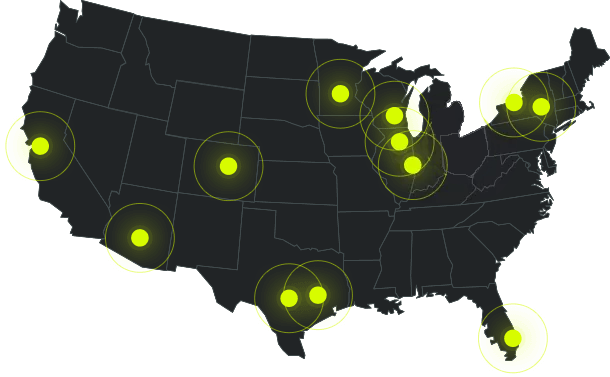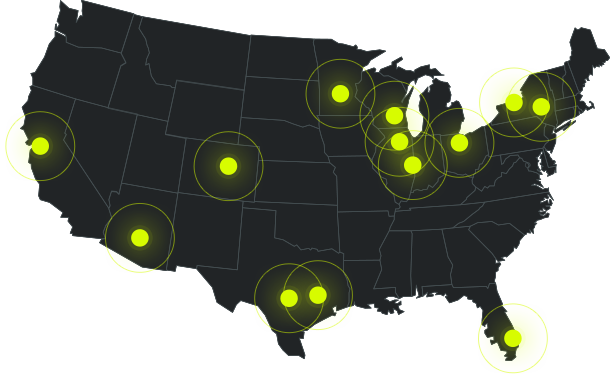CNC Parts in As Soon As 5-Days / / Get A Quote
What is CNC Machining?
Computer Numerical Control (CNC) machining is a manufacturing process during which a pre-programmed computer software directs the movement of factory machinery and tools. CNC machining can control a variety of complex machinery, from mills and routers to grinders and lathes. Using CNC machining allows three-dimensional cutting tasks to be accomplished with a single set of prompts. This process has become popular because there is no need for a live operator to push levers, buttons or wheels. Once a CNC machine has been activated, the cuts are programmed into the software and then communicated to the tools and machinery which perform the task.
CNC machining is ideal for projects requiring production-grade materials and rapid prototyping of tight tolerance plastic and metal parts with excellent surface finishes. The repeatability of the process also opens up the possibility of producing high volume manufacturing of parts using CNC machining.
CNC Parts in As Soon As 5-Days / / Get A Quote
How Does CNC Machining Work?
CNC machining can be simplified into a 3-step process / /
- A CAD file is designed
- A CNC technician translates the CAD file into the CNC program
- The CNC program is initiated and the part is machined
CNC Machining Design Limitations / /
There are several key considerations to keep in mind when designing your product for CNC machining.
- Workholding / / A part’s geometry will dictate how it will be positioned on the CNC machine and the amount of setup required. If a part must be manually repositioned, this can result in a small positional error. This can also impact the cost of the project as well as part accuracy.
- Tool Stiffness / / The tool used to cut the part may vibrate while operating. Tool stiffness may result in loose tolerances.
- Workpiece Stiffness / / Temperatures and cutting forces developed during machining may cause the workpiece to vibrate or even cause deformities. There is a minimum wall thickness and a maximum aspect ratio of tall features that the part must have to prevent workpiece stiffness.
- Tool Geometry / / CNC machining cutting tools have a cylindrical shape and a flat or rounded end. This can restrict the CNC machined parts geometries. The inside vertical corners of the part produced will have a radius, even if a small cutting tool is used.
- Tool Access / / If the cutting tool is unable to reach a surface, it cannot be CNC machined. This places a limitation on parts that require hidden internal geometries and sets a limit on the maximum depth of an undercut. For complex parts, consider metal 3D printing using Direct Metal Laser Sintering (DMLS).
Conventions Used to Describe CNC Procedures / /
There are several different types of CNC machinery. Here is a summary / /
- 2 Axis / / The cutting takes place on the same plane—the cutter does not have any capability of movement in the Z plane.
- 3 Axis / / The project requires cutting with simultaneous controlled movement along the X, Y, Z axes.
- 4 Axis / / Means the above plus one rotary axis movement is included—this may be 4 axis simultaneous interpolation or 4th axis positioning where the 4th axis repositions the part between 3 axis operations, but does not move during machining.
- 5 Axis / / The cutting occurs entirely in planes parallel to the main plane, but not always at the same height or depth—the cutter may move on the Z plane to switch levels, but not at the same time as the X or Y movements.

Different Types of CNC Machines / /
A CNC machine follows a coded program to modify a piece of material to meet specifications. The code is written by a person or translated from CAD or CAM software. They often use G-code or M-code. Some of the most frequently used CNC machines include / /
- CNC Mills / / The most basic mills consist of an X, Y, Z system and newer mills with three axes. Most CNC mills run on programs following letter- and number-based prompts that instruct pieces to move certain distances. Face milling, tapping, drilling, turning and shoulder milling are all functions of a mill. On a CNC mill, the workpiece is held in place. Cutting tools or drills attached to a spindle remove pieces of material from the workpiece.
- Lathes (CNC Turning) / / Lathes deliver circular cuts with precision and high velocity. Lathes are commonly used for complex designs not possible with a manual machine. Most CNC lathes have two axes, X and Z. Some models have more than two axes, which allows them to do more advanced jobs. On a lathe, the material is held on a rotating spindle. The non-rotating cutting tool or drill traces the perimeters of the part, forming the geometry or shape.
- Plasma Cutters / / Material is cut using a plasma torch. Plasma cutters are mainly used for metal materials, but other materials may be used. The machine generates heat and speed by using compressed-air gas and electrical arcs.
- Electric Discharge Machines (EDM) / / Two workpieces are cut and shaped by using electrical sparks via the use of electrodes. As the space between these electrodes shrinks, a current passes through, which removes a portion of the workpiece. This method is sometimes called die sinking, spark machining, spark eroding, burning, or wire erosion. Subtypes include Wire EDM and Sinker EDM.
- Water Jet Cutters / / High-pressure water jets are used to cut hard materials such as metal or stone. Water jets are often employed when the material cannot bear high-heat.
- Other tools with CNC variants include CNC routers, 3D printing, induction hardening machines, surface grinders, milling machines and more.
History of CNC Machines / /
Modern-day CNC machines are robotic or automated systems with multi-axis and tooling capabilities. During the late 40s, the original numerically controlled machine was made by John T. Parsons while working with MIT and the defense industry. Technology had been progressing up to this point throughout history from the 18th century steam-powered machine automation and as far back as 700 B.C. Italian craftmanship.
CNC Machining FAQs / /
Q: What language is used by CNC machines?
A: CNC machines are primarily programmed using G-code though M-code is also acceptable.
Q: Are CNC and VMC the same?
A: No. A computer controls CNC machines. A VMC is a kind of CNC machine used to cut metal.
Q: What is the difference between PLC and CNC?
A: Programmable Logic Controller (PLC) is sequential while CNC is conditional.
Q: Who invented CNC machining?
A: John T. Parsons
Q: What is the significance of CNC machining?
A: As the process is automated, it increases efficiency, lowers costs and increases accuracy.
Q: What materials can be used in CNC machining?
A: Depending on the application, common materials include stainless steel, copper, brass, aluminum, titanium, foam, polypropylene, ABS, POM, PC, Nylon and more.
Q: What are the five different CNC machines?
A: CNC lathe machine, router machine, milling machine, laser cutting machine and plasma cutting machine.
Q: What is the difference between DNC and CNC?
A: A direct numerical control (DNC) system uses a mainframe computer to operate multiple machines. DNC refers to the networking of more than one CNC machine.
Q: What is an NC machine?
A: Numerical Control (NC) machines receive instructions from a punch card, whereas a CNC machine receives instructions from a computer.
Q: What industries use CNC machining?
A: Aerospace, medical device, photonics, defense, electronics, transportation and more.
Q: What type of finish is produced by CNC machining?
A: Some CNC machines, such as the CNC mill, may leave visible tool marks. Because of this, additional finishing may be required to finish the part.
Q: What are the standard finishes for CNC parts?
A: Bead blast, anodized, chem film, passivation, powder coat, electropolishing, electroless nickel plating, silver plating and gold plating.
CNC Machining Quotes / /
CNC Parts In As Soon As 5-Days / / Get A Quote













